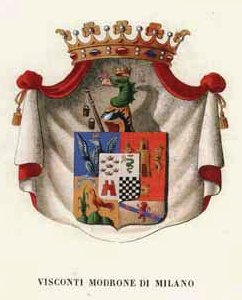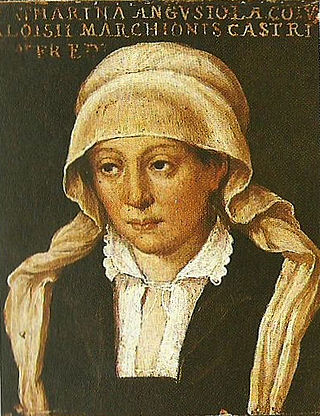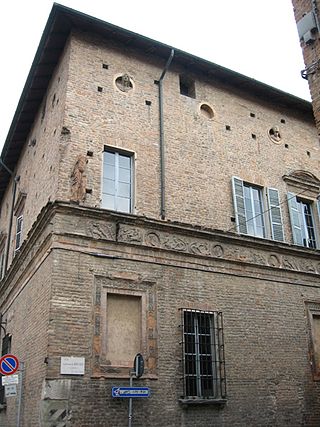
Piacenza is a city and comune (municipality) in the Emilia-Romagna region of Northern Italy, and the capital of the eponymous province. As of 2022, Piacenza is the ninth largest city in the region by population, with more than 102,000 inhabitants.

Castell'Arquato is an Italian town located on the first hills of Val D’Arda in the province of Piacenza, in Emilia-Romagna, approximately 30 kilometres (19 mi) from Piacenza and 35 kilometres (22 mi) from Parma. Places nearby include Bacedasco, Vigolo Marchese, Fiorenzuola d'Arda, Lugagnano Val d'Arda, and Vernasca. It is one of I Borghi più belli d'Italia.
Palazzo Farnese is a palace in Rome, Italy.

Palazzo Farnese is a palace in Piacenza, northern Italy.

Cosimo Morelli was an Italian architect, active throughout the Papal States in a Neoclassic style.

The Palazzo Brentani is a monumental Neoclassical palace, located on Via Manzoni #6, in the centre of Milan, region of Lombardy, Italy. Both this palace and the adjacent Palazzo Anguissola Antona Traversi have sober academic facades, designed by Luigi Canonica in 1829.

The Palazzo Anguissola Antona Traversi is a palace located at Via Manzoni number 10, in central Milan, a city in the northern Italy. Construction began in 1778, and its Neoclassical facade, designed by Luigi Canonica, was added in 1829.

The Sanvitale conspiracy was a plot to assassinate Ranuccio I Farnese, Duke of Parma and Piacenza, and members of his family at the baptism of his new-born son Alessandro in 1611. The conspiracy may also be referred to in Italian as the congiura dei feudatari, "conspiracy of the feudal lords", or as the congiura del 1611, "conspiracy of 1611".

Palazzo Comunale is a Gothic style palace located facing Piazza del Cavalli in the historic center of Piacenza, northern Italy which now serves as the seat of municipal administration. The facade is flanked by two bronze equestrian statues sculpted by Francesco Mochi and depicting the Farnese Dukes of Parma: Ranuccio (1612–20) and his father, Alexander (1620-1629). Across the piazza is the late-Baroque or early neoclassic Palazzo del Governatore (1787) designed by Lotario Tomba. Recessed and to the right is the 17th-century Collegio dei Mercanti.
The following is a timeline of the history of the city of Piacenza in the Emilia-Romagna region of Italy.

The House of Visconti di Modrone is a collateral branch of the Visconti of Milan. It originated in the 17th century and still exists today.

The Visconti Citadel of Piacenza is a fortification erected by the Visconti of Milan in the 14th century in Piacenza, Emilia-Romagna, northern Italy. In the 16th century, a new building was planned and initiated on the Citadel's site but remained uncompleted. Therefore, about half of the Citadel was not destroyed and survived until today.

Caterina Anguissola Trivulzio was an Italian noblewoman.

The Palazzo del Collegio dei Mercanti is a baroque-style palace located recessed and to the left of the Palazzo Gotico facing Piazza del Cavalli in the historic center of Piacenza, northern Italy. It now houses the offices of the town hall and council.

The Palazzo Landi is a Renaissance-style palace located on Via dei Consiglio #15 in the historic center of Piacenza, northern Italy.

The Palazzo Anguissola di Grazzano is a late-Baroque and early Neoclassical architecture-style palace located at Via Roma #99 in central Piacenza, region of Emilia-Romagna in Italy.
The Teatro Municipale or Municipal Theater of Piacenza is the main Neoclassical-style opera house in the city, located on Via Verdi #41, facing Piazza Sant'Antonino and flanking the Palazzo Anguissola di Cimafava Rocca in Piacenza, Italy.

The Palazzo Anguissola di Cimafava Rocca, also called Palazzo Anguissola Rocca is an 18th-century aristocratic palace located on Via Pietro Giordano #2, west and across the street from the Teatro Municipale in Piacenza, Region of Emilia Romagna, Italy.
The Scotti is an aristocratic family centered around Piacenza in Northern Italy. The family is also known as also known as Douglas Scotti for claiming descendancy from the Scottish Clan Douglas.
This page is based on this
Wikipedia article Text is available under the
CC BY-SA 4.0 license; additional terms may apply.
Images, videos and audio are available under their respective licenses.














